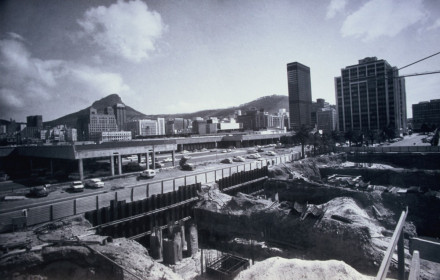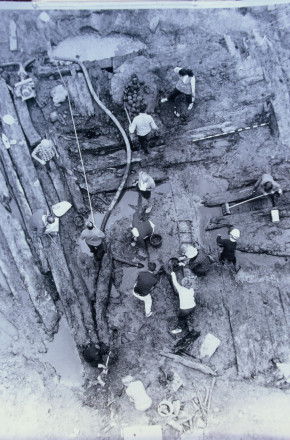History
As an East Indiaman built for the Chamber of Middelburg in 1760, the Nieuw Rhoon embarked on its maiden voyage to Canton (China) in 1766. After its return to the United Provinces in 1767, it would make four more return voyages (spanning the years 1767-1769, 1769-1771, 1771-1773 and 1774-1776).
Her last voyage started on the 22nd of November 1776 when she left Ceylon to Patria. Nearing the Cape of Good Hope on the 30th of January, the ship hit a storm. Due to a South Eastern wind, the ship drifted towards Robben Island and struck a reef and started taking on water.
Master Jacobus Coelders made sure to direct the vessel to more shallow waters where the vessel was intentionally run aground near the Castle Jetty.
Due to the intense activity still going on around the Nieuw Rhoon, the unloading of the ship took several days.
Priority lay with the goods which would spoil, such as the coffee beans and the spices which could easily rot. These were hauled off the ship to the mainland, to ensure they would not get wet.
An investigation report dated to the 26th of February states that the clashing of the ship’s keel against the rocks of Robben Island had caused the keel to be completely or partially broken off and had dented the garboards. This event breached the hull and caused the intake of water. Due severity of the leakage, there was no way to pump the water out of the hull, so the ship was declared irreparable.
According to a resolution from the 18th of March 1777, the ship was dismantled properly and any useful items were redistributed to both people and posts around the cape colony.
Description
| Skipper | Jacob Coelders |
|---|---|
| Length | 150 feet (45.7 m) |
| Tonnage | 1150 ton (575 last) |
Status
Civic centre wreck
The wreck was known as the 'Civic Centre ship' as she was found during the construction of the Civic Centre Building on the foreshore of Cape Town in 1970.


The wreck was discovered and excavated during the building of the Cape Town Civic Centre in the 1970s. It was recorded and excavated by Bob Lightly, who then went on to identify it as possibly being the Nieuw Rhoon, due to the small number of artefacts on board and the large amount of ballast, which indicated that the ship had possibly been deliberately sunk. However, it remains to be conclusively proven that this ship was indeed the Nieuw Rhoon.
The pine sheathing of the wreck had only been nailed once indicating a relatively new vessel since three or four sheathings were common during the lifetime of a ship. The pine sheathing was applied as protection from shipworm (Teredo navalis).
Since the vessel was dismantled, however, it would make it difficult to say whether any material would have been left at the site. Leijh therefore questions whether it was the wreckage material of the Nieuw Rhoon found on the premises of what is now the Civic Centre building, christened as the Civic Centre ship. Theoretically, it’s possible that not all of the ship’s structural remains have been removed when it was beached, but the conclusions would depend on the remains found at the Civic Centre site. What is for certain, however, is that the Nieuw Rhoon did indeed lie at this location.
Excavated material from the Civic Centre Ship is held at Iziko museums, Cape Town. The Iziko Museum received timbers and the clay pipes. The Timbers are not yet conserved or studied. There are some small artefacts which were also recovered during the excavation and may be from the wreck.
The wreck site is protected in terms of the National Heritage Resources Act, No. 25 of 1999. This act regards historic shipwrecks as well. The site may not be disturbed without the permission of the South African Resources Agency (SAHRA) and artifacts removed from the wreck may not be traded without SAHRA's permission.

References
- DAS 7955.5.
- NA-1.11.01.01-551, Lijst van alle zoodanige Schepen in soorten als bij de Generale Oostindische Compagnie zijn gemaekt oft gekocht als gehuurt alsmede waer oft de zelfde zijn agter gebleven ofte verongelukt als genoomen en verbrand, vermist of.
- Lesa la Grange, Martijn Manders, Briege Williams, John Gribble and Leon Derksen (2024).
Dutch Shipwrecks in South African Waters: A Brief History of Sites, Stores and Archives [Unpublished]. - NL-HaNA_1.04.02_4280_0106.